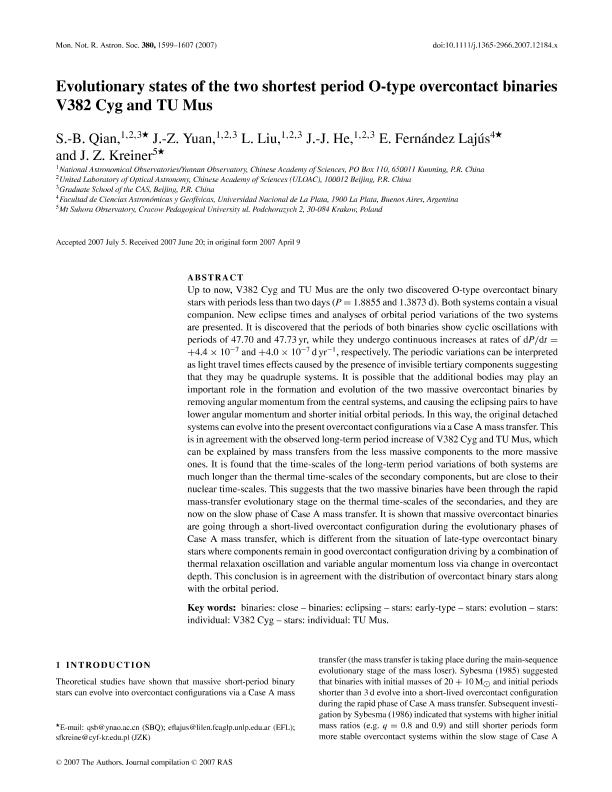Mostrar el registro sencillo del ítem
dc.contributor.author
Qian, S.-B.
dc.contributor.author
Yuan, J.-Z.
dc.contributor.author
Liu, L.
dc.contributor.author
He, J.-J.
dc.contributor.author
Fernandez Lajus, Eduardo Eusebio

dc.contributor.author
Kreiner, J. Z.
dc.date.available
2018-04-13T14:48:45Z
dc.date.issued
2007-10
dc.identifier.citation
Qian, S.-B.; Yuan, J.-Z.; Liu, L.; He, J.-J.; Fernandez Lajus, Eduardo Eusebio; et al.; Evolutionary states of the two shortest period O-type overcontact binaries V382 Cyg and TU Mus; Wiley Blackwell Publishing, Inc; Monthly Notices of the Royal Astronomical Society; 380; 4; 10-2007; 1599-1607
dc.identifier.issn
0035-8711
dc.identifier.uri
http://hdl.handle.net/11336/41984
dc.description.abstract
Up to now, V382 Cyg and TU Mus are the only two discovered O-type overcontact binary stars with periods less than two days (P = 1.8855 and 1.3873 d). Both systems contain a visual companion. New eclipse times and analyses of orbital period variations of the two systems are presented. It is discovered that the periods of both binaries show cyclic oscillations with periods of 47.70 and 47.73 yr, while they undergo continuous increases at rates of dP/dt = +4.4 × 10−7 and +4.0 × 10−7 d yr−1, respectively. The periodic variations can be interpreted as light travel times effects caused by the presence of invisible tertiary components suggesting that they may be quadruple systems. It is possible that the additional bodies may play an important role in the formation and evolution of the two massive overcontact binaries by removing angular momentum from the central systems, and causing the eclipsing pairs to have lower angular momentum and shorter initial orbital periods. In this way, the original detached systems can evolve into the present overcontact configurations via a Case A mass transfer. This is in agreement with the observed long-term period increase of V382 Cyg and TU Mus, which can be explained by mass transfers from the less massive components to the more massive ones. It is found that the time-scales of the long-term period variations of both systems are much longer than the thermal time-scales of the secondary components, but are close to their nuclear time-scales. This suggests that the two massive binaries have been through the rapid mass-transfer evolutionary stage on the thermal time-scales of the secondaries, and they are now on the slow phase of Case A mass transfer. It is shown that massive overcontact binaries are going through a short-lived overcontact configuration during the evolutionary phases of Case A mass transfer, which is different from the situation of late-type overcontact binary stars where components remain in good overcontact configuration driving by a combination of thermal relaxation oscillation and variable angular momentum loss via change in overcontact depth. This conclusion is in agreement with the distribution of overcontact binary stars along with the orbital period.
dc.format
application/pdf
dc.language.iso
eng
dc.publisher
Wiley Blackwell Publishing, Inc

dc.rights
info:eu-repo/semantics/openAccess
dc.rights.uri
https://creativecommons.org/licenses/by-nc-sa/2.5/ar/
dc.subject
Close Binaries
dc.subject
Eclipsing Binaries
dc.subject
Early Type Stars
dc.subject
Evolution of Stars
dc.subject
V382 Cyg (Estrella)
dc.subject
Tu Mus (Estrella)
dc.subject.classification
Astronomía

dc.subject.classification
Ciencias Físicas

dc.subject.classification
CIENCIAS NATURALES Y EXACTAS

dc.title
Evolutionary states of the two shortest period O-type overcontact binaries V382 Cyg and TU Mus
dc.type
info:eu-repo/semantics/article
dc.type
info:ar-repo/semantics/artículo
dc.type
info:eu-repo/semantics/publishedVersion
dc.date.updated
2018-04-09T16:55:44Z
dc.journal.volume
380
dc.journal.number
4
dc.journal.pagination
1599-1607
dc.journal.pais
Reino Unido

dc.journal.ciudad
Londres
dc.description.fil
Fil: Qian, S.-B.. Chinese Academy of Sciences; República de China
dc.description.fil
Fil: Yuan, J.-Z.. Chinese Academy of Sciences; República de China
dc.description.fil
Fil: Liu, L.. Chinese Academy of Sciences; República de China
dc.description.fil
Fil: He, J.-J.. Chinese Academy of Sciences; República de China
dc.description.fil
Fil: Fernandez Lajus, Eduardo Eusebio. Universidad Nacional de La Plata. Facultad de Ciencias Astronómicas y Geofísicas; Argentina
dc.description.fil
Fil: Kreiner, J. Z.. Cracow Pedagogical University; Polonia
dc.journal.title
Monthly Notices of the Royal Astronomical Society

dc.relation.alternativeid
info:eu-repo/semantics/altIdentifier/doi/http://dx.doi.org/10.1111/j.1365-2966.2007.12184.x
dc.relation.alternativeid
info:eu-repo/semantics/altIdentifier/url/https://academic.oup.com/mnras/article/380/4/1599/1062514
Archivos asociados
